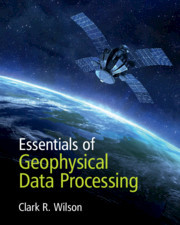Description
Essentials of Geophysical Data Processing
Author: Wilson Clark R.
Language: English
Subject for Essentials of Geophysical Data Processing:
Approximative price 52.22 €
In Print (Delivery period: 14 days).
Add to cart
Publication date: 10-2021
350 p. · 20.2x25.4 cm · Paperback
350 p. · 20.2x25.4 cm · Paperback
Description
/li>Contents
/li>Biography
/li>
A concise introduction to geophysical data processing - many of the techniques associated with the general field of time series analysis - for advanced students, researchers, and professionals. The textbook begins with calculus before transitioning to discrete time series via the sampling theorem, aliasing, use of complex sinusoids, development of the discrete Fourier transform from the Fourier series, and an overview of linear digital filter types and descriptions. Aimed at senior undergraduate and graduate students in geophysics, environmental science, and engineering with no previous background in linear algebra, probability, or statistics, this textbook draws scenarios and datasets from across the world of geophysics, and shows how data processing techniques can be applied to real-world problems using detailed examples, illustrations, and exercises (using MATLAB or similar computing environment). Online supplementary resources include datasets for students, and a solutions manual and all the figures from the book as PowerPoints for course instructors.
Preface; 1. An Introduction With Geophysical Time Series Examples; 2. Analog Signals and Digital Time Series; 3. Sinusoids and Fourier Series; 4. The Discrete Fourier Transform; 5. Linear Systems and Digital Filters; 6. Convolution and Related Theorems; 7. Least Squares; 8. Linear Filter Design; 9. Least Square and Correlation Filters; 10. Power and Coherence Spectra; Appendix A. Matrices and Vectors; Appendix B. Fourier Transforms of Continuous Functions; Appendix C. Random Variable Concepts and Applications; Appendix D. Further Reading; Index.
Clark R. Wilson is the Carlton Centennial Professor of Geophysics at the University of Texas, Austin. After undergraduate studies in physics (University of California, San Diego) and graduate work in geophysics (Masters and PhD) at Scripps Institution of Oceanography, he joined the faculty of the Department of Geological Sciences at UT Austin. His research has ranged over diverse fields including applied seismology, space geodesy, and hydrology. He has twice served as Department Chair, and spent three years at NASA Headquarters overseeing programs in geodynamics and potential fields.
© 2024 LAVOISIER S.A.S.




